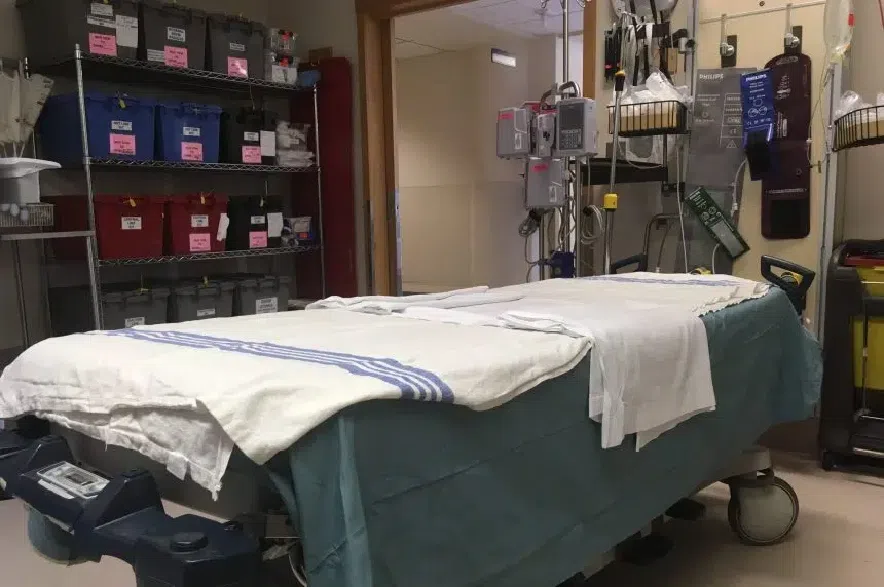The Saskatchewan Health Authority says it has added more than 100 community and hospital beds to Saskatoon and Regina through its Capacity Pressure Action Plan.
The plans for Saskatoon and Regina were enacted in the closing months of 2023 in response to serious overcrowding issues at hospitals. In one instance, the fire department was called to a hospital in Saskatoon after the number of patients in hallways created fire code issues.
The COO of the health authority, Derek Miller, said Thursday the authority is taking the situation seriously and the two plans are about addressing the root causes of the problems and the day-to-day challenges.
“I do acknowledge that, on a day-to-day basis, if we experience situations where the demand for services in our emergency department exceed our capacity, then it does place our physicians and our staff in a difficult spot, and we really appreciate them and their commitment to work through those,” Miller said during a Zoom call with reporters.

Derek Miller, the chief operating officer of the Saskatchewan Health Authority, discusses the progress of authority’s capacity plans for Regina and Saskatoon. (Screenshot)
John Ash, the vice-president of Integrated Saskatoon Health, said they’re already seeing some results from what’s been done on the plans and he’s encouraged by that. He spoke about the 32 temporary transition beds that were put in Saskatoon in December.
“We’re already seeing a reduction in the number of patients that are waiting in our acute-care facilities for a community resource or support. What that does is it frees up a bed allowing for those patients waiting in the emergency department or waiting to be admitted to access an appropriate acute-care facility,” explained Ash.
However, the leadership at the health authority acknowledged there’s more work to be done. Ash said the plans aren’t about quick, unsustainable fixes; he said it’s about improving the system.
“(We’re) taking that broader perspective on what are going to be our future needs and how can we continue to position ourselves to be able to meet the needs of the community, not only today but tomorrow,” said Ash.
In the months since the plans were announced, the health authority said it has added 116 hospital and community beds in the two major urban centres, and has hired 90 people in Saskatoon and will post more than 50 position in Regina soon. Another 140 permanent positions are expected to be posted around Saskatchewan.
“We anticipate in the next number of weeks many of those staff will be working on the floors providing good-quality, safe care,” said Ash.
The new beds in Saskatoon include 43 acute-care beds and three ICU beds at Royal University Hospital, five acute-care beds at St. Paul’s Hospital and 32 transitional beds.
In Regina, the health authority said it has added 27 additional beds in the community-based long-term care program and six hospice beds at the Wascana Rehabilitation Centre.
The authority said it plans to add up to 400 transitional, convalescent and long-term care beds to the two cities, and is currently working to identify locations.
Ash said the authority has also been listening to front-line workers for ideas on how to improve things like having an ECG tech who can do cardiac monitoring 24/7 in Saskatoon, or adding more resources in the triage areas in Regina to manage that demand as quickly as possible.
Meanwhile, the Ministry of Health has embarked on a plan aiming to add 1,000 new workers to the health-care system over the next few years.
Nurses concerned about overcrowding at RUH
The Saskatchewan Union of Nurses (SUN) says overcrowding has reached dangerous levels in one of the province’s major hospitals.
SUN president Tracy Zambory said Royal University Hospital in Saskatoon had 80 people waiting in emergency Wednesday night, with many of them in beds in the hallway.
She says eight patients required psychiatric treatment and of those, three were on stretchers for 120 hours.
Zambory said having that many mental health patients waiting too long can result in dangerous situations where staff can be harmed.
She says nurses also called the fire marshal to find spaces for patients.
— With files from 980 CJME’s Lisa Schick and The Canadian Press











